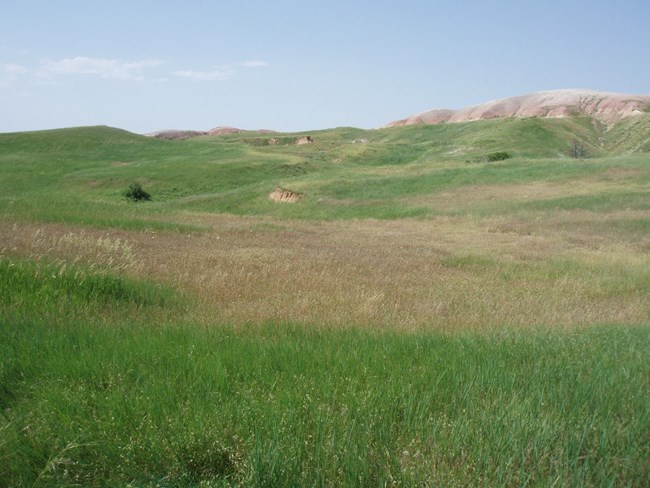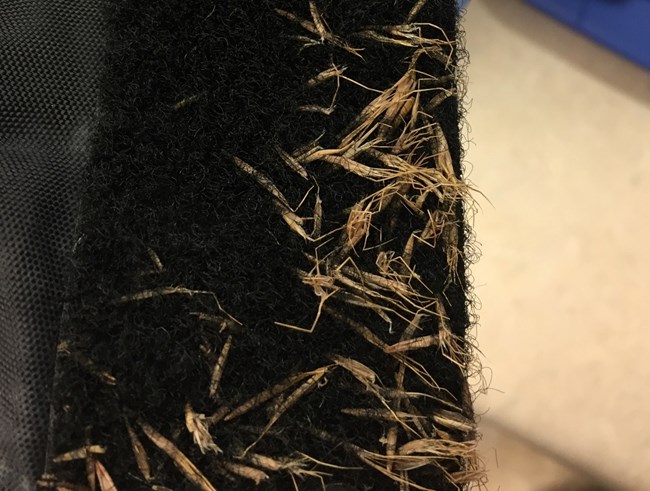Last updated: August 19, 2024
Article
Working Together to Control Invasive Plants and Restore Prairies

NPS photo – Northern Great Plains Inventory & Monitoring Network

USGS photos – Amy Symstad
National parks preserve natural and historical landscapes and the wildlife that depend on them. Park managers work to maintain healthy, natural ecosystems with a variety of plants and animals native to the region.
Invasive species are plants or animals not native to a region that cause ecological harm to the native species. Two annual brome grasses from Europe and Asia – cheatgrass and Japanese brome – impact grasslands in the northern Great Plains and throughout the Intermountain west. These two grasses, which are called “annual bromes” for short, make up to 30% of the plant community in some parks in the northern Great Plains.

NPS Photo
Annual Bromes Don’t Play by the Rules
Most native plants in the Great Plains – including at Wind Cave National Park – are perennial. Although they look dead in the winter, they’re just sleeping. They’ll sprout green again in the spring from their belowground parts, and they can do this for many years. Annual plants die every year. They rely on the seeds they produce each year to keep their population going. So, they usually produce lots of seeds. Each annual brome plant makes hundreds – sometimes thousands – of seeds!
Annual bromes ‘cheat’ native plants by starting to grow early in the spring, before the native perennial plants have woken up. The annual bromes use precious soil moisture and nutrients that the native species need, which makes it easier for them to crowd out perennial species. The annual bromes grow quickly, produce their seeds, then die, usually by mid-July. So, areas invaded by annual bromes appear brown during the summer months, while uninvaded areas are still green.
Annual bromes reduce grassland health in many ways. They replace the nutritious native perennial grasses that are the main food for grazers like bison and cattle. Annual bromes also displace the flowering plants important to pollinators such as bumble bees, butterflies, and beetles, and to seed-eating birds and small mammals. Their dry seeds have sharp tips that can cause sores in the mouths of grazers, and small mammals don’t seem to like annual brome seeds even though there are so many of them. And for hikers wanting to enjoy the grasslands, those seeds can be annoying or even painful!

Learning by Doing, Together
Because of all these impacts, park managers want to reduce annual bromes in invaded areas and keep them from invading new places. Natural processes, such as fire, are the preferred tool for controlling invasive plants, but herbicide application is sometimes necessary. To better determine when and where to use these tools to control annual bromes and restore native plants, the National Park Service partnered with researchers at the United States Geological Survey to build the Annual Brome Adaptive Management framework. Called “ABAM” for short, this framework helps managers of northern Great Plains parks use “real-time” data and science to make cost-effective decisions for reducing annual bromes and increasing native plant species.
Adaptive management is often described as “learning by doing”, but it’s more like an experiment spread out through space and time. ABAM uses a mathematical model to predict how a suite of possible management actions – prescribed fires, herbicide applications, or various combinations of the two – will affect the plants in specific locations within each park. The model considers what plants are in each location now, the type of soil they’re growing in, and possible future weather conditions. Each year, park managers use the model’s predictions to decide where they will apply each management action. After the fire is completed or the herbicide applied, biologists with park monitoring programs measure how the plants changed in the treated areas, then those data are added to the model. Did the plants react like the model predicted?

NPS Photos

Every new year’s worth of data will improve the model’s predictions, and the people using it will learn from their management actions. Implementing management actions, collecting data, and maintaining the ABAM model require more time and resources than a single park has. But collaboration among the seven parks, the prescribed fire, herbicide application, and monitoring teams that serve them, and scientists with the U.S. Geological Survey overcomes that limitation.
Greg Schroeder is the chief of natural resource management at Wind Cave National Park. He sums up ABAM this way: “ABAM is a great example of how shared information can contribute to continued learning. Each partner in this project applies their unique skillset towards a common interest that benefits the collective whole. Improving the health of the habitat benefits the wildlife supported by these park lands and optimizes our visitors’ experience.”

NPS Photo
Be Part of the Solution
Park visitors can help prevent invasive species problems in many ways, both at the park and at home:
-
Check your shoes, gear, pets, and vehicles for seeds as you hike or travel, especially before you enter or leave a new recreation site. Remove seeds and put them in the trash.
-
Purchase weed-free hay for your livestock and horses.
-
Use only local firewood to keep from transporting insects that attack plants.
-
Learn to identify the most problematic species in your home region and wherever you’re travelling.
-
Before buying a new plant for your yard, do a quick internet search to see if it’s invasive.
-
Support prescribed fire efforts and inform yourself about the importance and benefits of prescribed fire within northern Great Plains ecosystems.
Visit www.playcleango.org for more ways to care for our public lands.
Tags
- agate fossil beds national monument
- badlands national park
- devils tower national monument
- fort laramie national historic site
- little bighorn battlefield national monument
- scotts bluff national monument
- wind cave national park
- wind cave national park
- devils tower
- agate fossil beds national monument
- scotts bluff national monument
- badlands national park
- fort laramie
- little bighorn battlefeild
- invasive plant management
